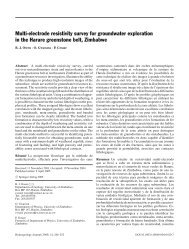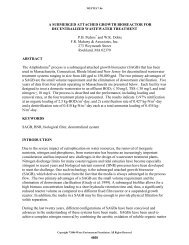Species diversity in the Florida Everglades, USA - Environmental ...
Species diversity in the Florida Everglades, USA - Environmental ...
Species diversity in the Florida Everglades, USA - Environmental ...
You also want an ePaper? Increase the reach of your titles
YUMPU automatically turns print PDFs into web optimized ePapers that Google loves.
Aquat. Sci. Vol. 68, 2006 Overview Article 275<br />
The overlap between an emergy based approach to<br />
ecosystem evaluation and network analysis/ascendency<br />
is fertile ground for ongo<strong>in</strong>g research. It is critical that<br />
<strong>the</strong> fi nd<strong>in</strong>gs of this paper be extended <strong>in</strong> two ways. First,<br />
coupl<strong>in</strong>g emergy and ascendency should be viewed as a<br />
priority as a result of <strong>the</strong> implicit assumption <strong>in</strong> ascendency<br />
analysis (and o<strong>the</strong>r ecological fl ow analyses – e.g.<br />
Dame and Patten, 1981) that energy fl ows on all bilateral<br />
pathways are directly comparable (i.e., equal quality), a<br />
conclusion at odds with energy systems <strong>the</strong>ory. This can<br />
be achieved us<strong>in</strong>g simple systems that have already been<br />
carefully exam<strong>in</strong>ed as part of previous research efforts<br />
(see Ulanowicz, 1997; Odum and Coll<strong>in</strong>s, 2003; Bardi et<br />
al., 2005 for widely cited examples).<br />
Second, we believe this technique should be extended<br />
to numerous systems with vary<strong>in</strong>g levels of disturbance<br />
and successional state, and <strong>in</strong> so do<strong>in</strong>g, additional metrics<br />
of system development and status should be quantifi -<br />
able. Wetlands differ <strong>in</strong> <strong>the</strong>ir capacity to support higher<br />
trophic level organisms (e.g., <strong>the</strong> Okavanago has a much<br />
higher grazer and predator biomass than <strong>the</strong> <strong>Everglades</strong>)<br />
and it is currently unknown how <strong>the</strong> EOET responds <strong>in</strong><br />
o<strong>the</strong>r ecosystems, nor how effective <strong>the</strong> cross-trophic<br />
level <strong>diversity</strong> <strong>in</strong>dices are at captur<strong>in</strong>g whole system condition.<br />
The data required to develop <strong>the</strong>se <strong>in</strong>dices are not<br />
widely collected; <strong>in</strong> particular, acquir<strong>in</strong>g <strong>the</strong> necessary<br />
level of compartment specifi city and fl ow detail is resource<br />
<strong>in</strong>tensive. However, as part of a global effort to<br />
understand and quantify <strong>the</strong> condition of large wetland<br />
ecosystems like those described <strong>in</strong> this volume, <strong>the</strong> necessary<br />
data are identifi able and methods for <strong>the</strong>ir estimation<br />
could be easily standardized.<br />
Summary<br />
A brief overview of <strong>the</strong> rich biota of <strong>the</strong> Greater <strong>Everglades</strong><br />
system was given across groups (plants, mammals,<br />
<strong>in</strong>sects, fi sh, birds). While <strong>the</strong>se are considered vital for<br />
conservation prioritization, we argue that such catalogs<br />
are of limited value for assess<strong>in</strong>g ecological systems. An<br />
alternative approach is <strong>the</strong> application of <strong>in</strong>formation<br />
<strong>the</strong>oretic <strong>in</strong>dices, an endeavor with a long history <strong>in</strong> ecology.<br />
We present two critical limitations of <strong>the</strong> conventional<br />
application of <strong>the</strong> Shannon <strong>diversity</strong> equation, and<br />
offer energy-quality adjustment of ecosystem fl ows as a<br />
<strong>the</strong>oretical advance that allows application of this <strong>in</strong>dex<br />
at <strong>the</strong> ecosystem scale. This revised <strong>in</strong>dex has <strong>the</strong> additional<br />
value of mak<strong>in</strong>g <strong>the</strong> <strong>in</strong>dex benchmark of maximum<br />
evenness more realistic with<strong>in</strong> an ecosystem context.<br />
When applied to <strong>in</strong>dividual ecosystem components<br />
(EOET), <strong>the</strong> <strong>in</strong>dex can be contrasted with <strong>the</strong> condition<br />
of maximum fl ow evenness to yield a measure of conservation<br />
value for each ecosystem component. We observed<br />
that deviation from expected importance corresponded<br />
well with normative judgments of conservation value. We<br />
observed a signifi cant positive association between transformity<br />
and EOET for <strong>the</strong> gram<strong>in</strong>oid system and suggested<br />
that this relates to ecosystem-degradation.<br />
References<br />
Alsop, F. J. III, 2001. Birds of North America: Eastern region, Dorl<strong>in</strong>g<br />
K<strong>in</strong>dersley Limited <strong>in</strong> association with <strong>the</strong> Smithsonian<br />
Institution, New York, New York, 751 pp.<br />
Angermeier, P. L. and J. R. Karr, 1994. Biological <strong>in</strong>tegrity versus<br />
biological <strong>diversity</strong> as policy directives: Protect<strong>in</strong>g biotic resources.<br />
Bioscience 44: 690–697.<br />
Avery, G. N. and L. L. Loope, 1980. Endemic taxa <strong>in</strong> <strong>the</strong> fl ora of<br />
South <strong>Florida</strong>, Technical Report T-558, U.S. National Park<br />
Service, South <strong>Florida</strong> Research Center, <strong>Everglades</strong> National<br />
Park, Homestead, <strong>Florida</strong>, 39 pp.<br />
Avery, G. N. and L. L. Loope, 1983. Plants of <strong>the</strong> <strong>Everglades</strong> National<br />
Park: A prelim<strong>in</strong>ary checklist of vascular plants, 2 nd ed.,<br />
Technical Report T-574, U.S. National Park Service, South<br />
<strong>Florida</strong> Research Center, <strong>Everglades</strong> National Park, Homestead,<br />
<strong>Florida</strong>, 41 pp.<br />
Bardi, E., M. J. Cohen and M. T. Brown, 2005. A l<strong>in</strong>ear optimization<br />
method for comput<strong>in</strong>g transformities from ecosystem energy<br />
webs. In: M. T. Brown, E. Bardi, D. Campbell, V. Comar, S.<br />
Huang, T. Rydberg et al. (eds.), Emergy Syn<strong>the</strong>sis 3: Proceed<strong>in</strong>gs<br />
of <strong>the</strong> 3 rd Biennial Emergy Research Conference, Center<br />
for <strong>Environmental</strong> Policy, University of <strong>Florida</strong>, Ga<strong>in</strong>esville,<br />
<strong>Florida</strong>, pp. 63–74.<br />
Berner, L. and M. L. Pescador, 1988. The mayfl ies of <strong>Florida</strong>, University<br />
Presses of <strong>Florida</strong>, Ga<strong>in</strong>esville, <strong>Florida</strong>, 415 pp.<br />
Brown, L. N., 1997. Mammals of <strong>Florida</strong>, W<strong>in</strong>dward Publish<strong>in</strong>g,<br />
Miami, <strong>Florida</strong>, 224 pp.<br />
Brown, M. T. and E. Bardi, 2001. Emergy of Ecosystems, Folio #3<br />
<strong>in</strong> Handbook of Emergy Evaluation, Center for <strong>Environmental</strong><br />
Policy, Ga<strong>in</strong>esville, <strong>Florida</strong>, 93 pp.<br />
Brown, M. T. and R. A. Herendeen, 1996. Embodied energy analysis<br />
and emergy analysis: A comparative view. Ecological Economics<br />
19: 219–235.<br />
Christensen, V., 1994. Emergy-based ascendency. Ecological Modell<strong>in</strong>g<br />
72: 129–144.<br />
Dame, R. F. and B. C. Patten, 1981. Analysis of energy fl ows <strong>in</strong> an<br />
<strong>in</strong>tertidal oyster reef. Mar<strong>in</strong>e Ecology Progress Series 5: 115–<br />
124.<br />
Davis, J. H. Jr., 1943. The natural features of Sou<strong>the</strong>rn <strong>Florida</strong>, especially<br />
vegetation and <strong>the</strong> everglades, <strong>Florida</strong> Geological Survey<br />
Bullet<strong>in</strong> No. 25, Tallahassee, <strong>Florida</strong>, 311 pp.<br />
Davis, S. M. and J. C. Ogden, 1997. <strong>Everglades</strong>: The ecosystem<br />
and its restoration, St. Lucie Press, Delray Beach, <strong>Florida</strong>,<br />
826 pp.<br />
DeAngelis, D., L. J. Gross, M. A. Huston, W. F. Wolff, D. M. Flem<strong>in</strong>g,<br />
E. J. Comiskey et al., 1998. Landscape model<strong>in</strong>g for <strong>Everglades</strong><br />
Ecosystem Restoration. Ecosystems 1: 64–75.<br />
Douglas, M. S., 1947. The <strong>Everglades</strong>: River of grass, Mock<strong>in</strong>gbird<br />
Books, Inc., Cov<strong>in</strong>gton, Georgia, 406 pp.<br />
Duever, M. J., J. F. Meeder, L. C. Meeder and J. M. McCollom,<br />
1994. The climate of south <strong>Florida</strong> and its role <strong>in</strong> shap<strong>in</strong>g <strong>the</strong><br />
<strong>Everglades</strong> ecosystem. In: S. M. Davis and J. C. Ogden (eds.),<br />
<strong>Everglades</strong>: The ecosystem and its restoration, St. Lucie Press,<br />
Delray Beach, <strong>Florida</strong>, pp. 225–248.<br />
ENP, (n.d.). <strong>Everglades</strong> National Park Strategic Plan 2001–2005.<br />
<strong>Everglades</strong> National Park. Retrieved January 30, 2005 from<br />
http://www.nps.gov/ever/current/report.htm<br />
Fagan, W. F. and P. M. Kareiva, 1997. Us<strong>in</strong>g compiled species lists to<br />
make bio<strong>diversity</strong> comparisons among regions: A test case us<strong>in</strong>g<br />
Oregon butterfl ies. Biological Conservation 80: 249–259.
















